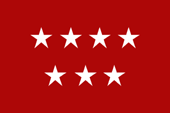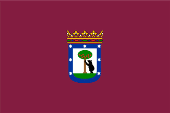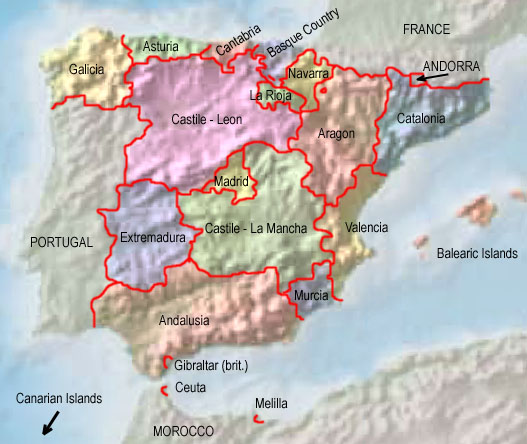Madrid |
|
|
|
| Übersicht – Contents: | |
Madrid |
|
|
|
| Übersicht – Contents: | |
Flaggen – Flags: |
|
 |
Flagge der Autonomen Gemeinschaft Madrid |
 |
Flagge der Stadt Madrid |
| Die Flagge der Communidad Madrid wurde per Gesetz vom 25.02.1983 offiziell eingeführt. Das Gesetz trat am 01.03.1983 in Kraft. Sie ist einfarbig karmesinrot und zeigt sieben fünfzackige weiße Sterne in zwei Reihen. Das Rot ist die Farbe Kastiliens, zu dem Madrid ursprünglich gehörte. Die sieben Sterne stammen vom Wappen der Stadt Madrid (obwohl diese dort sechszackig sind). Sie symbolisieren die sieben Sterne des Sternbilds des Großen Bären. Die Flagge wird in der Praxis nicht immer farbgetreu wiedergegeben. Sie erscheint oft nur in normalem Rot als in Karmesin. Die Flagge der Stadt Madrid ist einfarbig rot-violett (purpur) und zeigt in der Mitte das Wappen der Stadt. Die rot-violette Farbe wird Morado (Maulbeerfarben) genannt. | The flag of the Communidad of Madrid was officially established by law on 25th of February in 1983. The law came into force on 1st of March in 1983. It is a plain crimson coloured bunting and shows seven five-pointed white stars in two rows. The red is the colour of Castile, to which Madrid originally belonged. The seven stars come from the coat of arms of the City of Madrid (although they are six-pointed there). They symbolize the seven stars of the constellation Ursa Major. In practice, the flag is not always reproduced in true colour. It often appears only in normal red than in crimson. The flag of the city of Madrid is a solid red-violet (purple) colour with the city's coat of arms in the centre. The red-purple colour is called morado (mulberry). |
| Quelle/Source: Wikipedia (DE), Flags of the World, Volker Preuß | |
Wappen – Coat of Arms: |
|
 |
Wappen der Autonomen Gemeinschaft Madrid – coat of arms of the Autonomous Community of Madrid, Quelle/Source, nach/by: Wikipedia (DE) |
 |
Wappen Stadt Madrid – coat of the City of Madrid, Quelle/Source, nach/by: Wikipedia (ES), Valadrem, CC BY-SA 3.0, via Wikimedia Commons |
| Das Wappen der Communidad Madrid wurde offiziell am 23.12.1983 eingeführt. Es zeigt einen karmesinroten Schild mit sieben fünfzackigen weißen Sternen in zwei Reihen, darunter zwei goldene Burgen. Oberhalb des Schildes erscheint eine Königskrone. Das Rot ist die Farbe Kastiliens, zu dem Madrid ursprünglich gehörte. Die sieben Sterne stammen vom Wappen der Stadt Madrid, und auch die Burgen sind der Heraldik Kastiliens entnommen und stehen für Altkastilien und Neukastilien. Das Wappen der Stadt Madrid zeigt einen silbernen Schild mit einer blauen Umrandung. Auf dem silbernen Schild eine Szenerie in Naturfarben, die einen Bären zeigt, der an einen Erdbeerbaum schnuppert (botanischer Name: Arbutus unedo, spanisch: Madrono). Das Wappenbild erinnert an eine Einigung zwischen der Kirche und der Stadt bezüglich der Ländereien rund um Madrid. In dem blauen Rand des Schildes befinden sich sieben weiße sechszackige Sterne, sie symbolisieren die sieben Sterne des Sternbilds des Großen Bären. Oberhalb des Schildes eine stilisierte Königskrone. |
The coat of arms of the
Communidad Madrid was officially introduced on 23rd of December in 1983. It
features a crimson shield with seven five-pointed white stars in two rows,
including two golden castles. Above the shield is placed a royal crown. Red
is the color of Castile, to which Madrid originally belonged. The seven
stars come from the coat of arms of the city of Madrid, and the castles are
also taken from Castile heraldry and stand for Old Castile and New Castile.
The coat of arms of the city of Madrid shows a silver shield with a blue border. On the silver shield a scene in natural colors showing a bear sniffing a strawberry tree (botanical name: Arbutus unedo, Spanish: Madrono). The coat of arms commemorates an agreement between the church and the city regarding the lands around Madrid. In the blue border of the shield there are seven white six-pointed stars, they symbolize the seven stars of the constellation Ursa Major. Above the shield is placed a stylized royal crown. |
| Quelle/Source: Wikipedia (DE), Wikipedia (ES), Volker Preuß | |
|
Die autonomen Regionen Spaniens – The autonomous Regions of Spain: Interaktive Landkarte - interactive map |
 |
| Quelle/Source: Freeware, University of Texas Libraries, modyfied by: Volker Preuß |
| Zahlen und Fakten – Numbers and Facts: | |
|
|
|
|
|
|
|
|
|
|
|
|
|
|
| Madrid wird erstmalig in arabischen Quellen des 9. Jahrhunderts erwähnt. Im Jahre 1083 wurde Madrid durch König Alfons VI. von Kastilien von den Arabern befreit. Seit 1561 ist Madrid die Residenz der spanischen Könige und somit Hauptstadt. Im Jahre 1833 wurde ganz Kastilien in Provinzen unterteilt, Neukastilien (Kastilien südlich des Zentralspanischen Iberischen Scheidegebirges) in die Provinzen Madrid, Guadalajara, Cuenca, Albacete, Ciudad Real und Toledo, aus denen am 16.08.1982 die Autonome Gemeinschaft Kastilien-La Mancha hervorging. Madrid wurde am 01.03.1983 eine eigene Autonome Gemeinschaft. |
| Madrid is mentioned for the first time in Arabian sources of the 9th century. King Alfons VI. of Castile liberated Madrid from the Arabs in the year 1083. Since 1561 is Madrid the residence of the Spanish kings and in this way capital. In the year 1833 whole Castile was separated in provinces, New Castile (Castile southern the mountains of the Central System) in the provinces of Madrid, Guadalajara, Cuenca, Albacete, Ciudad Real und Toledo, and out of them arised the Autonomous Community of Castile-La Mancha on 16th of August in 1982. Madrid became an own Autonomous Community on 1st of March in 1983. |
| Quelle/Source: Wikipedia (DE), Volker Preuß |
| Der Ursprung des Namens und auch der Ortschaft "Madrid" aus der vor-arabischen Zeit ist ungeklärt. Die Araber veränderten den Namen der Ortschaft in "Madschrit", was "Weide" heißt. | The
origin of the name and even of the place "Madrid" from the pre-arabian times
is unknown. The Arabs changed the name of the place in "Madshrit", what
means "pasture". |
| Quelle/Source: Handbuch der geographischen Namen | |